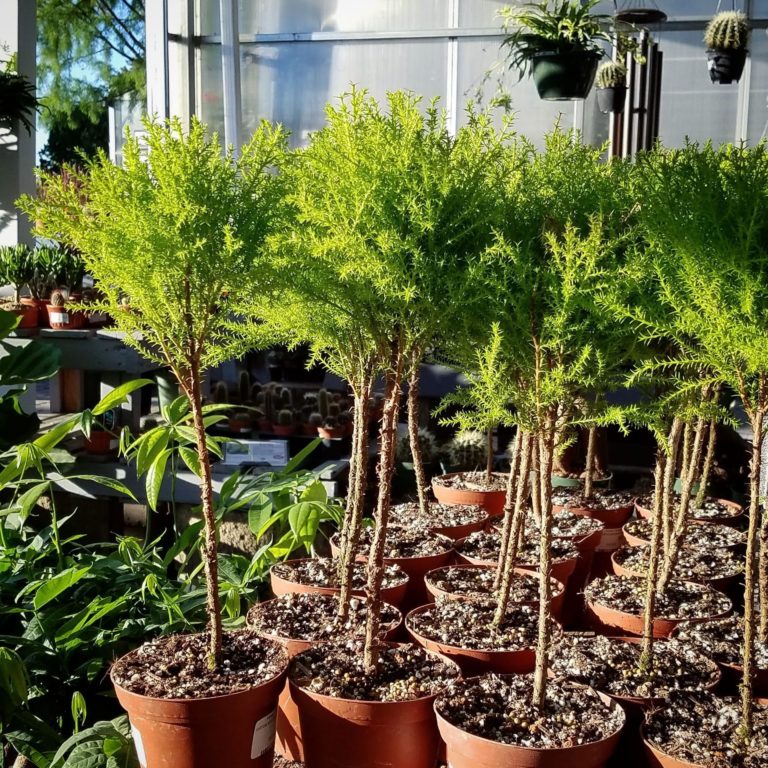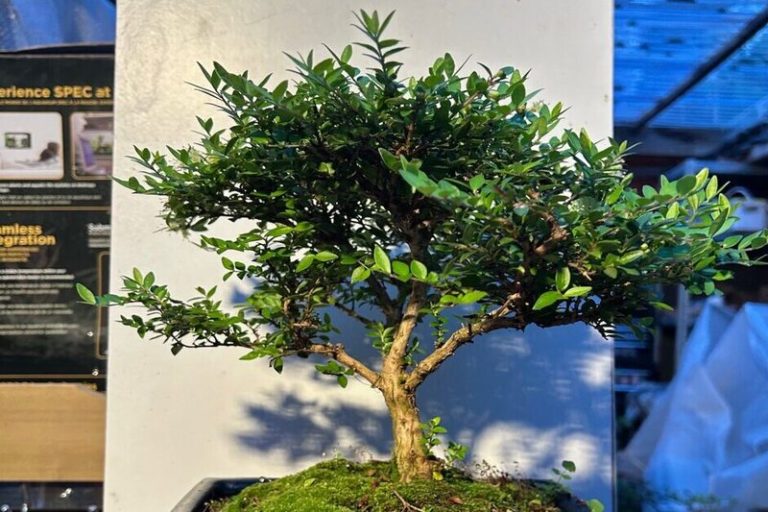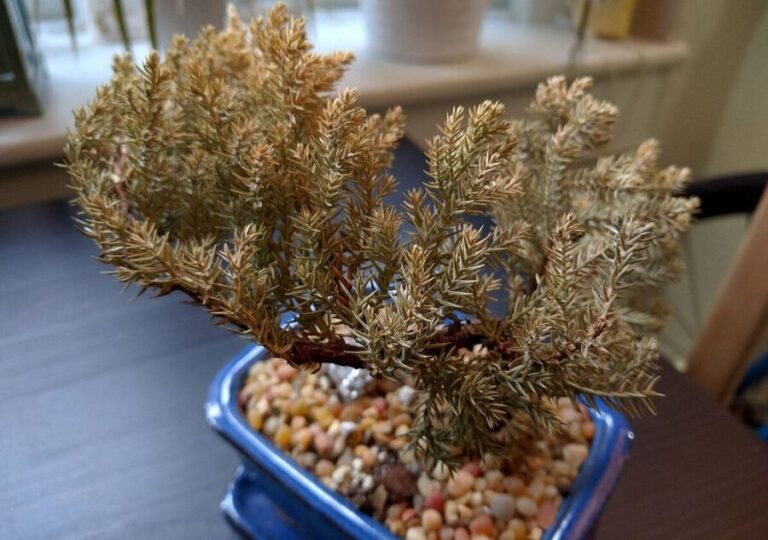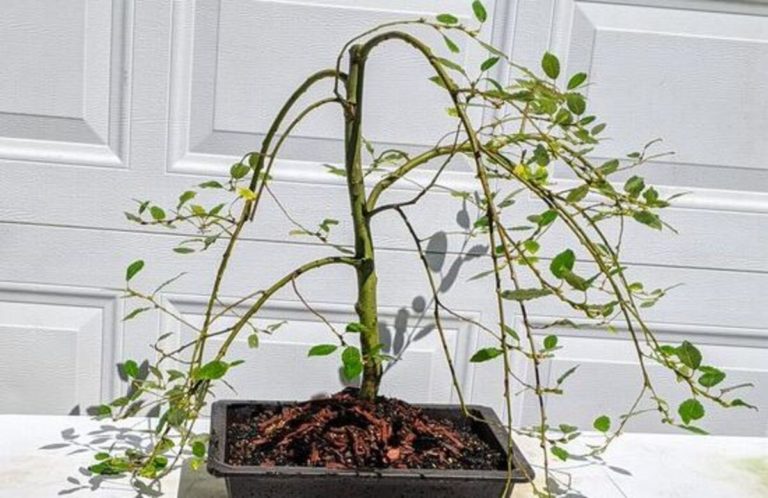Clump Style Bonsai: A Captivating Art Form for Nature Enthusiasts
Bonsai trees have long been valued for their unique beauty and calming properties. The clump style stands out among the numerous bonsai forms due of its own appeal. In this post, we’ll look at the world of clump style bonsai, including its characteristics, growning procedures, care suggestions, and the delights and challenges it offers.
What is a Clump Style Bonsai?
Clump style bonsai is a unique bonsai style where multiple trees are planted together in a single pot to create the illusion of a miniature forest. The trees are carefully chosen and arranged to resemble the natural growth patterns found in forests. This style adds depth, diversity, and a sense of harmony to the bonsai composition. Regular pruning and maintenance are required to maintain the balance and proportions of the trees. Clump style bonsai represents a tranquil and interconnected natural landscape in a compact form.

History and Origins of the Clump Style Bonsai
The history of clump type bonsai dates back to ancient China and Japan. Its roots may be traced back to the Chinese habit of constructing tiny landscapes known as “penjing” and “bonsai” in Japan.
The skill of penjing has been practiced in China for thousands of years. Penjing became popular as a form of creative expression during the Tang Dynasty (618-907). Chinese painters attempted to replicate natural environments in miniature, sometimes adding several trees to resemble forests or groves.
Later, the notion of clump style bonsai was transmitted to Japan, where it became an essential component of the bonsai heritage. Buddhist monks migrating from China to Japan during the Kamakura era (1185-1333) are thought to have carried the methods and styles of penjing with them. These inspirations had a significant impact on the development of Japanese bonsai.
In Japan, the clump style bonsai evolved as a distinct form known as “yose-ue” or “group planting.” Japanese bonsai artists embraced the idea of creating miniature forests and began cultivating bonsai compositions with multiple trees. They refined the techniques and principles to achieve a harmonious balance between the trees, showcasing the beauty and serenity of nature within a confined space.
Over time, the clump style bonsai gained popularity among bonsai enthusiasts worldwide. Bonsai artists and practitioners continue to explore and experiment with this style, incorporating different tree species, varying arrangements, and personal creative touches.
Today, the clump style bonsai remains a captivating and cherished form of bonsai art. It reflects the influence of both Chinese and Japanese traditions, serving as a testament to the enduring beauty and artistic expression associated with bonsai cultivation.
Characteristics of the Clump Style Bonsai
The clump style bonsai has numerous distinguishing characteristics that set it apart from other bonsai types. These features add to its distinct visual appeal, creating the illusion of a tiny forest within a single bonsai arrangement. The following are some essential characteristics of clump style bonsai:
- Multiple Trees: Multiple trees are planted together in a single container in the clump style bonsai. The trees are deliberately chosen to compliment one another in size, form, and species. This results in a dynamic and diversified layout reminiscent of a real forest or grove.
- Grouping and Proximity: The trees in a clump style bonsai are positioned close to each other, simulating the natural growth patterns observed in forests. They may vary in height and angle, creating a sense of depth and dimension within the composition.
- Dominant and Supporting Trees: The clump style often includes a central or dominant tree, known as the “parent tree,” which serves as the focal point. Surrounding the parent tree are smaller companion trees that act as supporting elements, enhancing the overall visual balance.
- Balance and Harmony: The clump style bonsai aims to achieve a harmonious balance among the trees. The arrangement is carefully planned to ensure that no single tree dominates the composition excessively. Each tree’s size, shape, and placement are considered to create a visually pleasing and balanced ensemble.
- Naturalistic Appearance: The clump style bonsai strives to mimic the organic and random growth patterns found in nature. The trees may exhibit varying trunk thickness, branch angles, and foliage density, imitating the complexity and diversity of a forest ecosystem.
- Pruning and Shaping: Regular pruning and shaping are essential in maintaining the clump style bonsai. The trees are carefully trimmed to control their growth, remove excess foliage, and maintain the desired proportions and overall aesthetics of the composition.
- Symbolism and Tranquility: The clump style bonsai symbolizes the beauty of nature and evokes a sense of tranquility and harmony. It represents a miniature landscape, capturing the essence of a forest within a confined space.
By combining these characteristics, the clump style bonsai creates a captivating visual display that showcases the interconnectedness of trees and the serenity of a natural landscape. It continues to be a beloved and sought-after style among bonsai enthusiasts worldwide.
Techniques for Creating Clump Style Bonsai
Creating a clump style bonsai involves specific techniques to achieve the desired appearance of a miniature forest or grove. Here are some essential techniques used in creating clump style bonsai:
Selection of Trees: Choose tree species that are suitable for the clump style bonsai. Select trees with different heights, trunk thickness, and foliage characteristics to create visual interest and mimic the diversity of a natural forest.
Preparing the Trees: Prepare the trees for transplantation by carefully pruning their roots and branches. This helps establish a proper balance between the root system and the canopy of each tree.
Wiring and Positioning: Use flexible bonsai wire to shape the trunks and branches of the trees. Position the trees in the bonsai pot, considering the desired composition and the visual flow of the arrangement. Experiment with different angles and heights to create a natural and harmonious grouping.
Soil and Potting: Use well-draining bonsai soil to ensure the health and vitality of the trees. Place the trees in the pot, ensuring that the roots are spread out evenly and properly positioned.
Pruning and Branch Selection: Regularly prune the branches to maintain the desired shape and balance within the clump. Remove any unwanted or crossing branches that disrupt the overall composition. Select branches that enhance the natural appearance and aesthetics of the clump style bonsai.
Styling and Branch Placement: Aim for a naturalistic look by positioning the branches in a way that mimics the random growth patterns observed in forests. Vary the branch angles and lengths to create depth and a sense of movement within the composition.
Regular Maintenance: Regularly monitor the growth of the trees in the clump and adjust their positioning or wiring as necessary. Maintain a consistent watering and fertilization schedule to ensure the trees’ health and vitality. Periodically trim the foliage to maintain the desired density and aesthetic balance.
Remember, creating a clump style bonsai requires patience, skill, and ongoing care. It is essential to regularly assess and adjust the composition to achieve the desired appearance of a miniature forest. With practice and attention to detail, you can create a stunning clump style bonsai that captures the essence of a natural grove.

Benefits and Challenges of Clump Style Bonsai
Clump style bonsai offers several benefits and presents unique challenges compared to other bonsai styles. Understanding these aspects can help bonsai enthusiasts make informed decisions about cultivating and appreciating clump style bonsai.
A: Benefits of Clump Style Bonsai:
Aesthetic Appeal: Clump style bonsai showcases the beauty of a miniature forest or grove, evoking a sense of tranquility and harmony. The intricate arrangement of multiple trees creates a visually captivating display that captures the essence of nature.
Naturalistic Representation: The clump style mimics the organic growth patterns observed in forests, providing a more realistic representation of nature compared to single-tree bonsai styles. It offers the opportunity to create miniature landscapes that reflect the interconnectedness of trees.
Visual Depth and Diversity: The combination of different tree species within a clump style bonsai creates a diverse and dynamic composition. Varying heights, trunk thickness, foliage colors, and textures enhance visual interest and depth, adding complexity to the bonsai’s overall appearance.
Symbolism and Serenity: Clump type bonsai represents nature’s beauty and tranquillity in a compact shape. It may convey a sense of tranquility, harmony, and connectedness to the natural world to any space, making it a relaxing presence.
B: Challenges of Clump Style Bonsai:
Selection and Compatibility: Choosing and sourcing the right tree species for a clump style bonsai can be challenging. It requires careful consideration of their growth habits, compatibility, and aesthetics to achieve a harmonious composition.
Composition and Balance: Creating a visually pleasing arrangement of multiple trees can be complex. Achieving a balanced composition, where each tree contributes to the overall harmony, requires skill and artistic judgment.
Maintenance and Care: Clump style bonsai requires regular pruning, shaping, and maintenance to keep the composition in balance. Careful monitoring of each tree’s growth and health is necessary to prevent one tree from overpowering the others or compromising the overall design.
Root and Soil Management: With multiple trees in close proximity, managing the root systems and soil becomes more challenging. Proper watering, soil aeration, and root pruning are crucial to maintain the health and vitality of each tree within the clump.
Limited Space and Potting: Accommodating multiple trees in a single pot restricts the available space for root growth. Regular repotting and root management are essential to ensure the trees have enough room to thrive while maintaining the desired clump style aesthetics.
Despite the challenges, the artistry and allure of clump style bonsai make it a rewarding endeavor for bonsai enthusiasts. With patience, skill, and careful attention to maintenance, the unique beauty of a clump style bonsai can be nurtured and enjoyed for many years.
Tips for Caring for Clump Style Bonsai
Caring for a clump style bonsai is crucial to maintain its health and ensure its long-term beauty. Here are some essential tips for caring for your clump style bonsai:
- Watering: Proper watering is essential for the health of your bonsai. Water your clump style bonsai when the soil surface starts to feel slightly dry. Avoid overwatering, as it can lead to root rot. Ensure that water penetrates the entire root system by watering thoroughly until it drains out from the bottom of the pot.
- Soil: Use well-draining bonsai soil that allows for proper water retention and aeration. Avoid compacted or waterlogged soil, as it can harm the roots. Regularly check the soil moisture level to prevent under or overwatering.
- Sunlight and Temperature: Place your clump style bonsai in a location that provides the appropriate amount of sunlight for the tree species involved. Most bonsai trees thrive in a balance of direct sunlight and partial shade. Monitor the temperature, as extreme conditions can stress or damage the bonsai. Protect the bonsai from frost, excessive heat, or strong winds.
- Fertilization: Fertilize your clump style bonsai regularly to provide it with essential nutrients. Use a balanced, slow-release bonsai fertilizer or organic alternatives. Follow the recommended dosage and fertilization schedule based on the tree species and the season.
- Pruning and Trimming: Regularly prune and trim your clump style bonsai to maintain its shape and size. Remove dead or diseased branches, and thin out dense foliage to allow for better airflow and light penetration. Ensure that the dominant tree and companion trees are proportionate to each other within the composition.
- Wiring and Training: Monitor the growth of the branches and use bonsai wire to guide and shape them as needed. Adjust the wiring regularly to prevent it from cutting into the branches. Be cautious when wiring multiple trees in a clump to maintain a natural and harmonious appearance.
- Repotting: Repot your clump style bonsai every few years, typically during the spring before new growth begins. Repotting helps refresh the soil, prune the roots, and maintain the health and vigor of the trees. Follow proper repotting techniques and ensure the new pot provides ample space for the trees to grow.
- Protection and Winter Care: Protect your clump style bonsai from extreme weather conditions, especially during winter. Shield it from freezing temperatures, heavy snow, or harsh winds. Consider providing winter protection such as a cold frame, greenhouse, or protective cover.
Remember, each tree species within your clump style bonsai may have specific care requirements, so it’s important to research and understand the needs of each tree involved. By providing the appropriate care, you can enjoy the beauty and longevity of your clump style bonsai for years to come.
Clump Style Bonsai Care Sheet
| Aspect | Care Tips |
| Watering | Water when the soil surface feels slightly dry. Avoid overwatering or allowing it to dry out completely. |
| Sunlight | Place in a location with the appropriate amount of sunlight for the tree species involved. |
| Most clump style bonsai prefer a balance of direct sunlight and partial shade. | |
| Temperature | Protect from extreme temperatures and sudden temperature fluctuations. |
| Avoid exposing the bonsai to frost or excessively high temperatures. | |
| Humidity | Clump style bonsai generally do well in average room humidity. |
| Fertilization | Use a balanced, slow-release bonsai fertilizer or organic alternatives. |
| Follow the recommended dosage and fertilization schedule based on the tree species and the season. | |
| Pruning and Trimming | Regularly prune and trim to maintain shape and balance within the clump. |
| Remove dead or diseased branches. Thin out dense foliage for better airflow and light penetration. | |
| Wiring and Styling | Monitor branch growth and use bonsai wire to guide and shape branches as needed. |
| Adjust wiring regularly to prevent it from cutting into the branches. | |
| Repotting | Repot every few years, typically during the spring before new growth begins. |
| Refresh the soil, prune the roots, and ensure the new pot provides ample space for growth. | |
| Pest and Disease Control | Regularly inspect the bonsai for pests or signs of diseases. |
| Take appropriate measures to control and prevent infestations or infections. | |
| Winter Care | Protect from freezing temperatures, heavy snow, and harsh winds. |
| Use winter protection such as a cold frame, greenhouse, or protective cover. | |
| Regular Maintenance | Continuously monitor the health and growth of each tree in the clump. |
| Adjust positioning, wiring, and pruning as necessary to maintain balance and aesthetics. |
Remember, these care tips provide general guidelines, but it’s important to consider the specific needs of each tree species within your clump style bonsai. Adjust the care routine based on your observations and the unique requirements of your bonsai.
Conclusion:
Clump style bonsai is a captivating art form that allows nature enthusiasts to bring the beauty of forests into their homes or gardens. By carefully selecting and arranging multiple trees, bonsai artists create miniature landscapes that captivate the eye and nourish the soul. While it may pose challenges, the rewards of creating and caring for clump style bonsai are immeasurable. So, why not embark on this enchanting journey and explore the artistry of clump style bonsai?
FAQ:
Q: What is Clump Style Bonsai?
A: Clump type bonsai is a bonsai style in which numerous trees are planted tightly together in a single container. It gives the appearance of a little forest or grove, with the trees grouped in a way that replicates natural development patterns.
Q: How is Clump Style Bonsai different from other bonsai styles?
A: Clump style bonsai is distinct in that it features multiple trees in a single composition, while other styles typically focus on a single tree. Clump style bonsai aims to create a more naturalistic representation of a forest or grove.
Q: What are the key characteristics of Clump Style Bonsai?
A: Clump style bonsai is characterized by the grouping of multiple trees, with a dominant or central tree and smaller companion trees. The trees are positioned close to each other, creating a sense of proximity and naturalistic arrangement.
Q: What are the benefits of Clump Style Bonsai?
A: Clump style bonsai offers a visually captivating display, resembling a miniature forest. It allows for a more diverse and dynamic composition, capturing the interconnectedness of trees. It also evokes a sense of tranquility and symbolizes the beauty of nature.
Q: How do I care for Clump Style Bonsai?
A: Caring for clump style bonsai involves proper watering, providing suitable sunlight and temperature conditions, regular pruning and trimming, fertilization, and repotting when necessary. It is important to monitor the health of each tree within the clump and ensure balanced growth.
Also Read:







